Have you ever wanted to know the name of every type of cricket shot? Have you ever wanted to know which shot you should be playing to which types of ball? If you have, then you’re in the right place.
Every batsman has a different style and technique which makes their shots look different to another player. However, most shots are given specific names like the pull shot, the hook shot, or the cover drive, as well as many more. That is what I’ll be aiming to do in this post. I’ll tell you what the shots are, when the shot should be played, how it should be played, and where it should be hit.
When I started playing for my local club side, I wanted information on which shots I should be playing to which balls, but there seemed to be nowhere that had all the information in one place! That is my inspiration for writing this post! Hopefully some of you that are reading this and trying to learn more about the game will find this list as useful as I would have all those years ago! Here are the shots I’m going to go through:
Front foot shots:-
- Straight Drive
- Cover Drive
- On Drive
- Square Drive
- Forward Defence
- Sweep
- Reverse Sweep
- Front Foot Leg Glance
Back foot shots:-
- Back Foot Drive
- Back Foot Defence
- Square Cut
- Pull Shot
- Hook Shot
- Back Foot Leg Glance
- Uppercut
Other shots:-
- Ramp Shot
- Switch Hit
Front Foot Shots
‘Front foot’ shots are given that title because they usually require the batsman to come forwards towards the bowler. This means that front foot shots are played to deliveries anywhere from a good length to yorker length. Now let’s go into more detail…
The Straight Drive
Where is it Hit?
I think it’s only right if I start with my favourite – the straight drive. It is widely regarded as one of the most graceful shots in the game when played correctly. It is hit in area that is highlighted red:
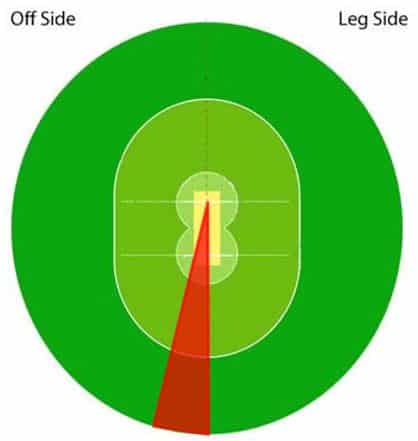
Which Deliveries Should it Be Played To?
This shot is usually played to deliveries of a good to full length that are on the middle stump or off stump line. If you’re not sure what a good length delivery is, or if you’re struggling with playing that type of ball, click here to read the detailed guide I’ve put together! It’ll definitely help you develop some new attacking and defensive strategies!
How is it Played?
This shot is a front foot shot, which means your front foot should be going down the pitch towards the area where the ball is bouncing. Your front leg should be bent slightly, and your head should be above your front knee. When you strike the ball, the bat face should be facing directly back towards the bowler. When striking the ball, a high front elbow is always advised! This allows the bat face to be delivered as straight as possible.
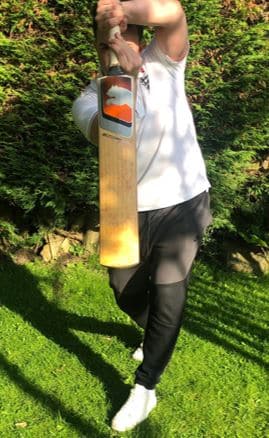
The Cover Drive
Where is it Hit?
This shot is very similar to the straight drive, the only real difference is the direction in which it is played! This time, the ball will be hit through the ‘covers’ (hence the name ‘cover drive’). If you don’t know where the ‘covers’ are on a cricket field, check the red zone in the diagram below to see where the shot should be hit:
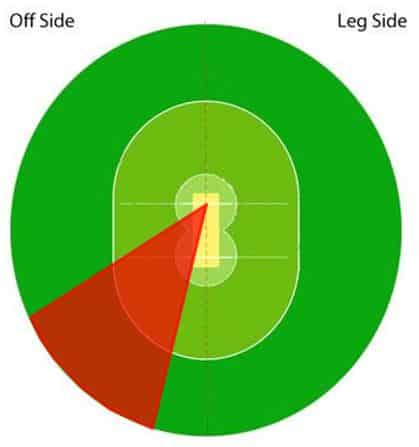
Which Deliveries Should it Be Played To?
This shot is played to deliveries of a good to full length that are on an off-stump line or wider.
How is it Played?
Following the same method as for the straight drive, this time our front foot must come forwards and towards the off side if the ball is on that line. Again, the front leg should be bent slightly with the head over the knee. This time you must angle the bat face towards the cover fielders and follow through in that direction. Try to ensure that the bat comes through nice and straight by maintaining a high front elbow and ‘holding the pose’ at the end of the shot like you see a lot of professionals doing! One of the biggest challenges with this shot is getting it past the fielders. Opposing captains will often have at least a couple of them in the cover area so your main challenge is being able to pick the gap on a regular basis!
I’ve written a more specific post about the cover drive, so if you want even more information you can read it by clicking here! That post will take you through every movement specifically, as well as giving you some drills that will help you practice the shot.

The On Drive
Where is it Hit?
Yep, you guessed it! This is another drive shot that Is played in a slightly different direction to the first two! This shot is played through the leg side, towards the mid-on and long-on fielding positions. This diagram will give a proper representation of where the shot should be played:
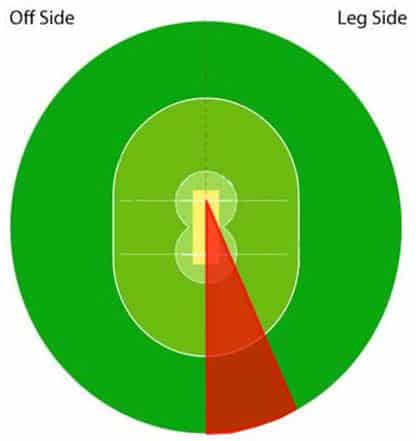
Which Deliveries Should it Be Played To?
The on drive is usually played to deliveries of a good to full length that are on a leg stump line or just sliding on to the pads.
How is it Played?
During the on drive, the front foot will ideally move straight forwards towards the pitch and line of the ball. The front knee should be slightly bent and the weight of your head should be over your front knee. As the bat comes through to strike the ball, the face should be angled towards the leg side of the bowler. Remember, having a nice high front elbow during this shot allows the bat to come through straighter and this is the most technically correct way to play the shot.
Here’s something to note: When batting, I see that many players’ first movement when facing a delivery is to take the front foot forwards towards the off side. If you do this when playing the on drive, it tends to put you at a higher risk of getting out LBW due to the fact that you are playing around your front pad. If you miss the ball…you’re toast! So, if your batting technique relies on this huge step across to the off-side with your front foot, work with your coaches on limiting this a little. This should serve you well, setting you up to play shots to all sides of the wicket more effectively.

The Square Drive
Where is it Hit?
This is a little bit more of a risky drive shot which is played through the off-side. It is hit slightly squarer than the cover drive. Check the red zone in the diagram below to see where it is hit:
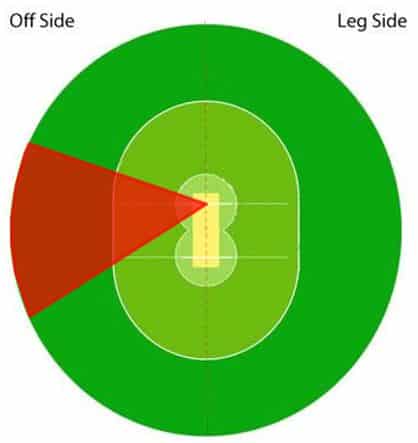
Which Deliveries Should it Be Played To?
This drive is also played to deliveries of a good to full length. The line of the delivery will usually be wide of off stump.
How is it Played?
To play the square drive, you should first make a stride towards the pitch and the line of the ball with your front foot. Ensure that the front leg is bent and that the head is over the front knee. Because the square drive is played to deliveries that are bowled quite wide of the off stump, there is no way you will be able to get your front foot all the way into line with the ball, and nor should you! As long as you get a decent length stride and remain balanced, then the hands and arms can do all the work for you. This shot is much more reliant on good hand-eye co-ordination.
The square drive is almost half way between a cover drive and a square cut, and as such the high front elbow is not as important here. Keep your eye on the ball and focus on ‘getting on top of the bounce’. This ensures that the ball will be hit into the ground, leaving less chance of a catch being taken. Try to play the ball late and flourish the hands as you make contact with the ball. This shot is a bit riskier than the other drives as it is played with the hands away from the body. As a batsman you should put your heaviest focus on watching the ball during this shot, as its incredibly important to make good contact with the bat. Playing away from the body like this can lead to more edges – both outside and inside which could result in you getting out caught or bowled!
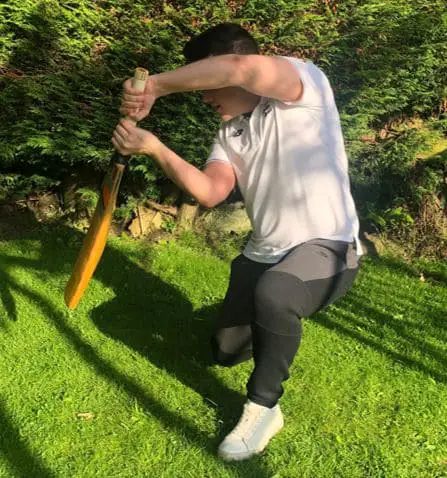
The Forward Defence
Where is it Hit?
The forward defence is a shot that all players must be able to play, because although we would like to attack all the time, sometimes it just isn’t advisable! It’s a shot that you’ll see played against all types of bowlers, and it isn’t really hit in a specific area. The goal is to just nullify the ball and hit it into the ground somewhere close to the wicket.
Which Deliveries Should it Be Played To?
The shot is usually played to balls of a good to full length that are threatening the stumps. When playing in a defensive mode, any delivery that is outside the line of the stumps can usually be left alone entirely.
How is it Played?
The technique used to play the forward defence is very similar to the technique used to play the drive shots. Except this time, there is no follow through! Your front foot should move towards the pitch and line of the ball and again, the front knee should be slightly bent, with the head over that front knee. The bat should come down next to the knee leaving minimal room in between bat and pad for a moving ball to sneak through. When you make contact with the ball, it is often best to angle the bat ever so slightly towards the ground, especially if there are fielders close by waiting to take a sharp catch! You’ll see a lot of batsmen mistiming the forward defence and popping up a return catch to the bowler! Angling the bat downwards slightly should eliminate this issue. Don’t play at the ball too forcefully when defending, it really isn’t necessary. You’ll often hear commentators talking about batsmen having ‘soft hands’, and this means that the batsman is not prodding at the ball too hard. If you allow the ball to come on to the bat, rather than the other way around, you’ll see less edges flying through to the keeper and the slips.
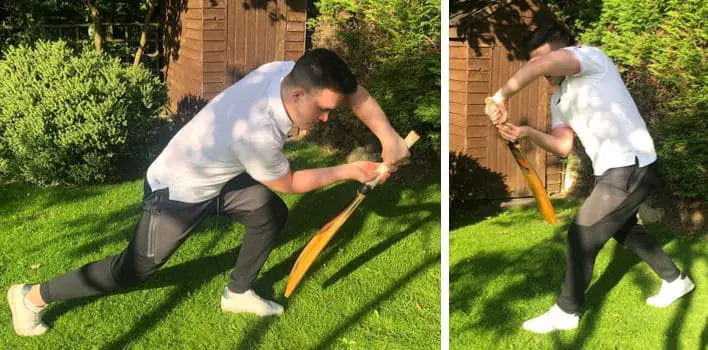
The Sweep
Where is it Hit?
The sweep is one of the more innovative front foot shots, and it is often played against slower bowlers such as spinners. It is usually hit anywhere behind square on the leg side, although it can also be hit slightly in front of square too.
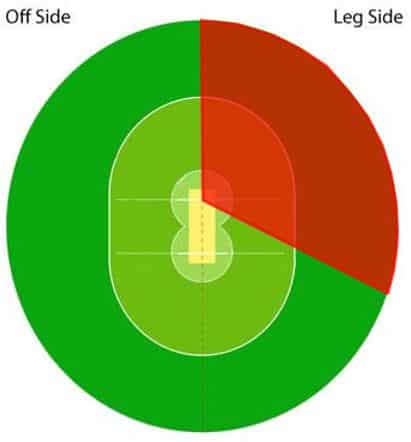
Which Deliveries Should it Be Played To?
The sweep shot is often pre-meditated. This means that the batsman will often decide to play the shot before the bowler runs in to bowl. It is most effective when it is played to balls on a good to full length. As for the line, you will most often see it played to deliveries that are pitching anywhere leg-side of the off-stump. You will also see it played to deliveries that are spinning towards the batsman’s body as these are easier to hit into the leg-side.
How is it Played?
During the sweep shot you should take a large stride down the pitch with your front foot. The stride should be a comfortable length, not large enough that it ruins your balance! The large stride helps you to smother the spin generated by the bowler, and may even mean that you can hit the ball on the full without having to judge the bounce. You should sink quite low into your stance, trying to bring your eye level down as much as is comfortable for you. From here you must hold the bat out in front of you with the bat face pointing towards the leg side. Now all you have to do is strike the ball. Sometimes you will need to make contact with the ball earlier and more forcefully in order to get it squarer, whereas other times you’ll need to use the pace and just glance the ball off the face of the bat to beat the fine leg fielder. Have a look around the field before you play the sweep shot and decide which gap you’re going to target.
The sweep is very useful as it can force the opposing captain to change his field drastically and put more fielders behind square on the leg side. This opens up opportunities in other areas of the field. It forms a vital part of any batsman’s arsenal as it helps us to play spin bowlers effectively when the pitch is turning a lot. On turning pitches, straight bat shots are riskier as there is less margin for error. The sweep is a cross bat shot, meaning that no matter how much the ball turns you should always be able to get bat on it. Sweep shots are less advantageous when playing on bouncy pitches or facing bowlers that get a lot of topspin and bounce. This is because there is more chance of a top edge!

The Reverse Sweep
Where is it Hit?
The reverse sweep is another innovative front foot shot that has become incredibly popular in modern cricket. All you need to know about the shot is in the name! It is simply the ‘reverse’ of the normal sweep…and as such it is usually hit behind square on the offside.
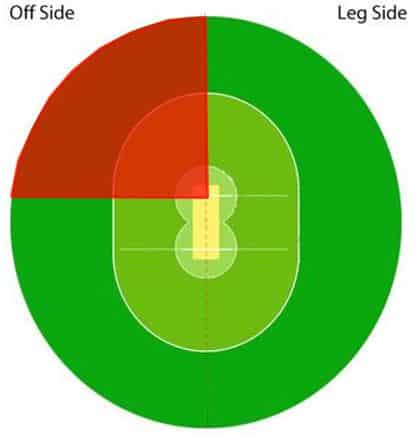
Which Deliveries Should it Be Played To?
Like the conventional sweep, the reverse sweep is usually a pre-meditated shot that is played to balls of a good to full length. This shot is also usually used against a spinner who is spinning the ball towards the offside of the batsman’s body, or a spinner who pitches the ball on the offside.
How is it Played?
The shot is played in a very similar way to the normal sweep, except this time you must manoeuvre your hands in a different way prior to the shot. Firstly, you should take a stride down the pitch with your front foot. The stride should be a comfortable length, not large enough that it ruins your balance! As mentioned earlier, the large stride helps to smother the potential spin of the bowler. Sink down nice and low into your stance, getting your eyes as low as possible whilst keeping them level. Now you must extend the bat out in front of you, with the bat face pointing towards the off-side. To do this simply roll your hands over whilst holding the bat in your hands. If you’re a right handed batsman, your right arm should now be over the top of your left when you get into the reverse sweep position. The opposite is true for left handers!
When striking the ball you will again have to analyse the field to pick the gaps behind square on the off-side. To get the ball to go down to the third man area try to hit the ball later and glance it off the face of the bat. To get the ball to go squarer try to hit the ball earlier and harder.

The Front Foot Leg Glance
Where is it Hit?
The leg glance is an incredibly useful front foot shot. It’s incredibly effective when looking to put a bad ball away, or steal a quick single. The front foot leg glance can be hit in various areas on the leg side, and this usually depends on how early or late we hit the ball. The areas I would be looking to hit the shot in are as follows:
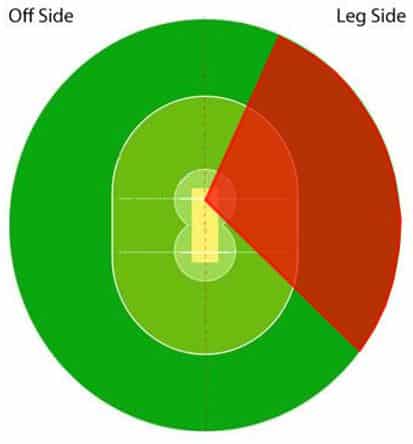
Which Deliveries Should it Be Played To?
I believe that any delivery on the line of middle stump or to the leg side of that is a candidate to be glanced into the leg side. It’s also important for the front foot leg glance that these deliveries are of a good to full length. As batsmen we generally don’t want to hit across the line of the ball too regularly, so any deliveries to the offside of the middle stump should not be considered great candidates for the leg glance.
How is it Played?
Like with the other front foot shots, we begin the motion of the shot by taking a stride down the pitch with our front foot. As you see the ball angling in towards your body, try to play the ball in the same way as you would with the on drive at first. Bring the bath through in a straight line with a high front elbow. This time, instead of following through with the bat in a straight line as you would with the on drive, you need to ‘roll’ or ‘flick’ the wrists as you make contact with the ball. It is this flicking motion that makes the shot risky, but also what makes it effective. This means that the ball is a lot more likely to go square or behind square on the leg side. This is definitely a type of shot where it is easy to use the pace of the bowler and simply glance the ball off the face of the bat. As I’ve mentioned when talking about some of the other shots, if you want the ball to go squarer, try to play the ball a split second earlier and with a tad more power. The slight bit of extra power is needed as we are making a ‘thicker’ contact with the ball when trying to hit it square of the wicket. If you want the ball to travel down towards fine leg then you want to get a relatively faint contact. Hitting the ball finer doesn’t require as much power as the ball will almost be continuing its original trajectory. Both of these options are effective when taking field placings into account.
When playing this shot be careful of ‘falling over’. A lot of batsmen let their heads fall too far towards the off side and as a result will often miss the ball, making themselves a huge LBW risk! If you have a problem with this then your coaches should be able to help you work on it during practice. The main thing to focus on to break yourself out of that habit is ensuring that your eyes remain level at all times while batting.

Back Foot Shots
As you may have already guessed, back foot shots get their name because a batsman will usually move backwards in their crease while looking to hit the ball. They are played to deliveries that bounce much higher, hence the need to move backwards slightly to play them effectively.
Back Foot Drive
Where is it Hit?
The back foot drive is another beautiful cricket shot. When I was growing up watching cricket the batsman who played this shot the best was Sachin Tendulkar…he always made it look so elegant! The back foot drive is played in similar areas to the front foot drives that I mentioned earlier in this post. Look at the diagram below to see where you should be looking to hit the shot.
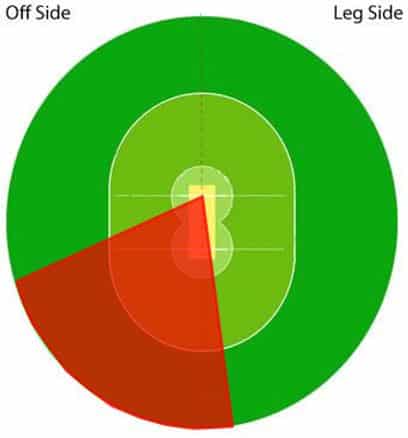
Which Deliveries Should it Be Played To?
This shot is usually played to deliveries that are back of a length and either on the line of the batsman’s body, on the stumps or just outside the line of off stump. If you’re not sure what I mean by the term ‘back of a length’ then click here to read another one of my post that explains it fully!
How is it Played?
Most batsmen will usually take a small step down the pitch before the bowler has bowled his delivery. This is called a ‘trigger move’. From this point, you must quickly diagnose the length of the ball and determine if the ball is short enough for you to rock on to the back foot. The trigger move will actually help you here because you can push off your front foot in order to move backwards in a quicker and more efficient way. To play the shot properly you must move backwards into line with the ball and stand as tall as possible with your feet relatively close together. Now focus on bringing the bat through the line of the ball as straight as you can. As with the front foot drives, it is important that you keep a high front elbow as you play the shot. This helps the bat to remain straight. If the line of the ball is on your body then you should ideally be looking to play the ball through the mid-on area. Deliveries on the line of middle/off stump should be played straight back down the ground, and deliveries just outside the line of off-stump should be played through mid-off.
The key to success with the back foot drive is more focused on timing rather than power. Getting the timing right on this shot is difficult but as the old saying goes…practice makes perfect! If you time the ball correctly then you don’t need much of a follow through with your hands to make the ball travel a good distance. All it needs is a little push to get it to the boundary!

Back Foot Defence
Where is it Hit?
Not all short balls can be attacked! In fact many of them are left alone entirely or defended. The back foot defensive shot allows you to do that. Due to the fact that it is a defensive shot you will not be looking to hit the ball in a specific area, you’ll just be trying to ensure the ball does not get close enough to a fielder to be caught. Especially if the fielding side has fielders positioned close to you! The goal here is to get on top of the bounce and direct the ball towards the ground!
Which Deliveries Should it Be Played To?
The back foot defence can be used by batsman that is looking to play in a defensive manner to deliveries that are back of a length.
How is it Played?
The technique used to play the back foot defence is very similar to the back foot drive. You should push backwards off your front foot and bring your feet close together whilst standing tall in your crease. Standing tall is vital to being able to get over the top of the delivery and directing it towards the ground. If the line of the ball is on your body, then bring the bat down straight, maintaining a high front elbow during the motion of the shot. Try to play the ball late rather than prodding towards the ball with the bat. The later you play the ball the less chance you will have of offering a return catch to the bowler! Also, make sure to keep your bat angled towards the floor as you make contact with the ball. This helps to make sure that the ball is played towards the ground rather than up in the air! Remember, you don’t have to hit every ball! If you judge that the ball is going to miss your as well as the stumps then it would probably be best to leave the delivery alone altogether!
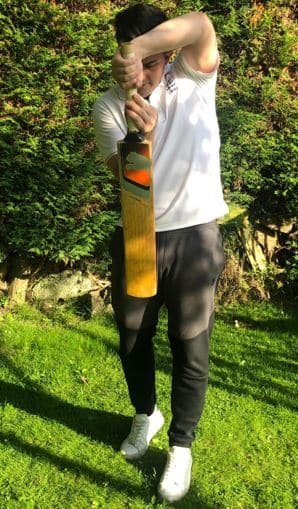
The Square Cut
Where is it Hit?
The square cut is one of the most frequently used scoring shots in cricket, and it can be incredibly useful for punishing bowlers that have bowled a bad delivery. It is played square of the wicket on the off-side, and if you watch cricket regularly, you’ll see a lot of boundaries being scored with this shot!
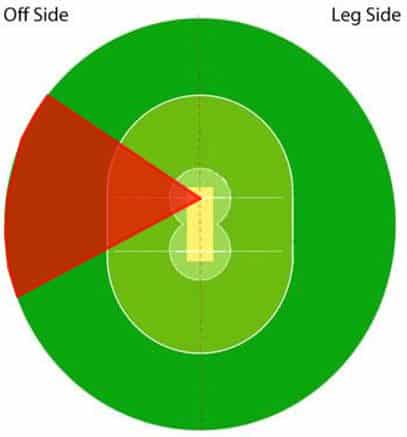
Which Deliveries Should it Be Played To?
The shot is played to back of a length or short deliveries that are wide of the off stump. The square cut relies on the batsman having the room to free his arms and strike the ball. Therefore, deliveries that are closer to the body are not suitable for this shot. Batsmen playing in an attacking mode may choose to back away to the leg side prior to the bowler releasing the ball in order to make the resulting delivery more suitable to be square cut to the boundary.
How is it Played?
This shot is all about identifying the line and length of the ball early. Once you notice that the ball is short and wide of the off stump you should rock back onto your back foot. Whilst keeping your eye on the ball, free your arms and try to strike the ball with a horizontal bat. Bear in mind that the later you play the ball, the squarer the shot will go. There is also a high probability that the ball will go backwards of square. Try to remain tall during the shot if you want the ball to travel along the floor. This gives you the best chance of being over the top of the ball when you make contact, making it more likely to go towards the ground. If you’re aiming to go up and over the fielders on the off side, try to get underneath the ball and try to hit it with a touch more power to get that extra elevation. To slower bowlers, you may be able to take a lateral step towards the ball with your back foot. This will allow you to play the square cut against even wider deliveries. To fast paced bowlers, large lateral movements of the back foot are not hugely practical and may not be as easy to execute!

The Pull Shot
Where is it Hit?
The pull shot is another one of a batsman’s most deadly weapons. The shot can be hit in a variety of areas on the leg side, ranging from mid-wicket to fine leg. This can be seen in the red area below:
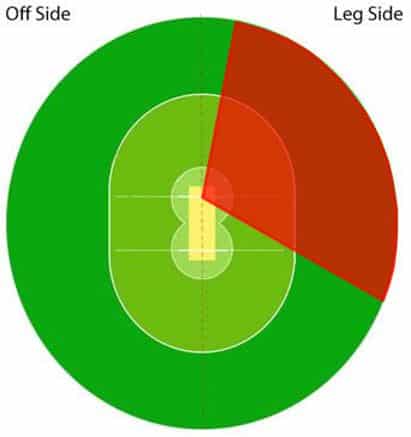
Which Deliveries Should it Be Played To?
The shot is usually played to back of a length balls that are either in line with the stumps, or on the batsman’s body. Using the pull shot against balls that are outside the off stump is not usually advisable as this can lead to more top edges and the risk of getting out caught. Pull shots are played when the ball is between waist and shoulder height on the batsman.
How is it Played?
To play the shot effectively you must identify the line and length of the ball early. From here, push backwards off your front foot so that the majority of your weight is on your back foot. As your weight transitions backwards your torso must rotate, bringing the bat through horizontally to intercept the rising ball. The front foot may leave the ground entirely as you go through this swivelling motion. It is this rotation of the torso as well as the hand speed that provides the power in the pull shot. As a guide I would tell players that the further the ball is bowled to the leg side, the less power you have to put into the shot. The ball only has to be helped or deflected around the corner, which means that the ball will usually go in the direction of fine leg. If the ball is closer to the line of the off stump this ball more manipulation to get it into the leg-side. You will have to hit this type of ball harder and usually this leads to the shot going much squarer.
The pull shot is incredibly easy to hit in the air, but whether or not you choose to do this has to depend on the field placings. If the fielding side has a man on the boundary on the leg side then it may be better to play a more controlled pull shot and hit the ball along the floor. To make sure that the ball travels downwards when you play your pull shot, try to ‘roll’ your wrists on contact. This basically means that you have to roll your bottom hand over your top hand as you hit the ball. If you’re interested in learning more about how to play this shot and how to improve your play against the short ball in general then I’d definitely recommend reading my ultimate guide on it here!

The Hook Shot
Where is it Hit?
The hook shot is also a shot that targets the leg side anywhere from mid-wicket to fine leg.
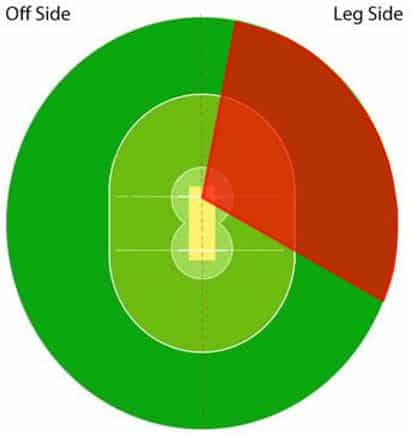
Which Deliveries Should it Be Played To?
This shot is incredibly similar to the pull shot in that it is usually played against fast bowlers who are bowling back of a length or short pitched deliveries that are on the line of the stumps or the batsman’s body. The hook shot differs from the pull shot due to the fact that it is played against deliveries that are over shoulder height.
How is it Played?
To play the hook, identify the line and length of the ball as early as possible before pushing backwards off your front foot. As the majority of your weight transitions to your back leg, rotate your torso and bring the bat through horizontally to intercept the rising ball. As your torso rotates your front foot may leave the ground entirely to accommodate the motion. It is the speed of the rotation as well as the hand speed that provides the power in the hook shot.
As with the pull shot, I would tell players that the further the ball is bowled to the leg side, the less power you have to put into the shot. The ball only has to be helped or deflected around the corner, which means that the ball will usually go in the direction of fine leg. If the ball is closer to the line of the off stump this ball more manipulation to get it into the leg-side. You will have to hit this type of ball harder and usually this leads to the shot going much squarer.
The hook shot is often hit in the air, however, if you intend to play it along the floor try to keep your hands high and get on top of the bounce as much as physically possible. You can also ‘roll’ your wrists on contact. As mentioned in the section above, to learn more about this shot and how to play more effectively against short pitched bowling I would really recommend reading my ultimate guide on it here…I think you’ll find it very useful!
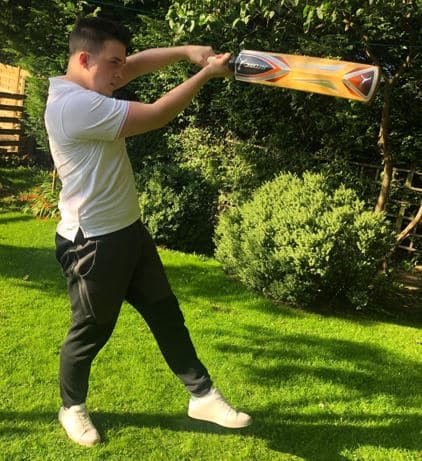
The Back Foot Leg Glance
Where is it Hit?
The leg glance is a great option for scoring easy runs off the back foot, and you’ll find it incredibly useful for rotating the strike during an innings. The back foot leg glance can be hit in various areas on the leg side, and this usually depends on how early or late we hit the ball. The areas I would be looking to hit the shot in are as follows:
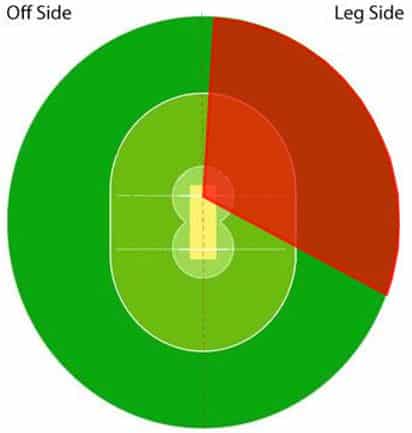
Which Deliveries Should it Be Played To?
This shot is usually played to back of a length or short deliveries that are comfortable enough to be played with a relatively straight bat. In terms of the line of the deliveries, you should look for balls that are in line with the stumps or anything on the line of the body and to the leg side of that. Put simply, anything that is comfortable to turn into the leg-side. I would not advise playing the back foot leg glance to deliveries that are to the off-side of off stump as this requires you to play across the line of the ball too much, potentially resulting in leading edges.
How is it Played?
To play this shot you must identify the line and length of the ball early and push back off your front foot. Use this movement to get into line with the ball, as well as moving back in your crease. When the ball reaches you, bring the bat through in a straight line, and lightly deflect the ball towards the leg side. You do not need a large follow through and the shot does not have to be played with power. Simply use the bat to direct the ball into a leg-side gap in the field. Try to keep your front elbow high throughout the shot and flick your wrists as you make contact. This is another shot that should be played as late as possible in my opinion, when the ball is right under the eyes. A finer contact on the ball will lead to it going in the direction of fine leg, whereas a thicker contact will send the ball squarer!

The Uppercut
Where is it Hit?
The uppercut is an innovative shot that found a lot of its popularity in the shorter formats of cricket. It is a shot that allows the batsman to hit the ball over the top of the slip region, or more broadly, in the air behind square on the off-side. If these names don’t make sense to you…then see the diagram below to see where the shot is usually hit:
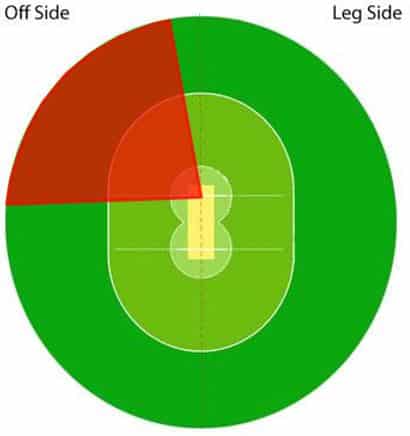
Which Deliveries Should It Be Played To?
The shot is usually played to back of a length or short balls that are outside the line of the off stump. The batsman must be able to get underneath the delivery to get elevation on the ball.
How is it Played?
Once you detect that the ball has been bowled short and wide enough to play the uppercut you must stay back in your crease whilst maintaining a solid base. From here, wait until the ball has risen to a good height where it is easy for you to get underneath the ball. When the ball has reached a comfortable height extend your arms and strike the ball. Angle the bat upwards, and focus on getting the ball airborne over any close fielders. If the ball already has a lot of pace on it then there is no need to try to strike the ball very hard. You are simply re-directing it up in the air using the angle of the bat. It is very important to remain well balanced throughout the shot and I would always recommend trying to play the uppercut as late as possible. This means that the ball will be more likely to go behind square on the off-side, somewhere over the region of the slip fielders. But obviously, the direction in which you look to play the shot depends entirely on the field placings!
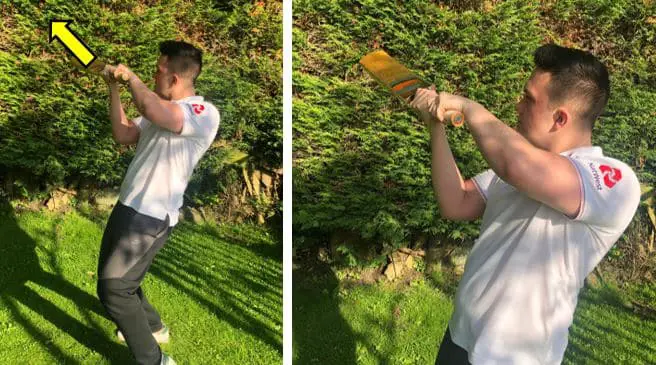
Other Shots
The Ramp Shot
Where is it Hit?
The ramp shot is another relatively recent addition to the game of cricket, becoming hugely popular in the last decade. Particularly in the one day formats of the game! There are a variety of different ways that you can play the ramp shot but you’ll mainly see the shot being played behind square on both sides of the wicket:
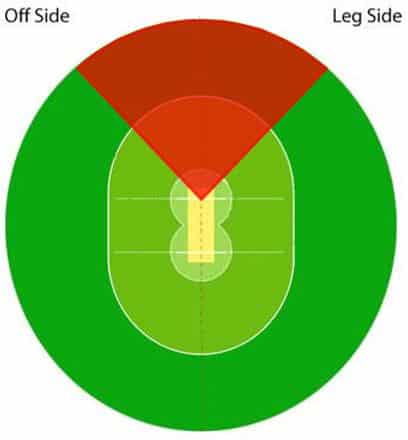
Which Deliveries Should It Be Played To?
The ramp is played to deliveries on a good to full length. It can also be played to full tosses or yorkers that are intercepted before they bounce. It is primarily a pre-meditated shot that the batsman will often get in position to play before the bowler has bowled the delivery.
How is it Played?
To play the ramp shot it is advised that you look to get into position just as the bowler is about to bowl the delivery. Like I said previously, there are a variety of different ways to play the shot, but most players will try to back away from the bowler and get into a front on position. From here, you should extend the bat out in front of you in a face-up position. All you have to do now is read the line and length of the delivery and use the bat to deflect the ball. The bat face should be tilted slightly to the left or right depending on which side of the wicket you are trying to direct the ball to. This is not a shot that needs you to hit the ball hard to be effective. It is all about positioning the bat properly and letting the bowlers pace do the work for you!
Make sure you have the correct protective equipment on whilst playing this shot. It is incredibly easy for the shot to go wrong and this could lead to the ball striking the batsman on the head. Try to get your head out of the way as you make contact with the ball.

The Switch Hit
Where is it Hit & Which Deliveries Should It Be Played To?
You don’t see the switch hit that often in cricket but when you do, it’s always impressive! This shot was popularised by Kevin Pietersen, and it allows a right hander to temporarily turn themselves into a left hander, or vice versa. The switch hit is not necessarily hit in any specific area, as once you have switched your stance around you can choose to play any shot you like. With this is mind, you can also play the switch hit against any type of delivery.
How is it Played?
The switch hit is a pre-meditated shot, and requires you to change your entire position at the crease before you hit the ball. With such a dramatic movement required, you’ll usually see batsman move just before the ball leaves the bowlers hand.
If you’re a right hander, you must turn around 180 degrees, making your right foot your front foot instead of your left. You also have to switch your hands around on the bat, making the right hand the new top hand. The opposite is true for left handers. Your left foot will become the front foot in your new altered stance, and the left hand will be the new top hand. I’d recommend watching videos of Kevin Pietersen playing this shot. He transitioned his stance in such a smooth and efficient way and this allowed him to maintain his balance at the crease before looking to play a shot. I also remember him saying that he spent hour after hour, day after day practicing this shot in the nets, and that that was the only reason he was confident enough to use it in a real game situation. You should approach your batting the same way! Make sure you’ve put the work in in the nets before you go into real matches!
Summary
All the explanations that you’ll find above feature basic step by step breakdowns of the lines and lengths you should be looking for or the positions you should be trying to get into when playing each shot. When batting, sometimes we have less than a second to react to the ball so it will be impossible to be thinking about all these things during that time! This post is intended to give an introduction to what is involved with each shot! Through practice and repetition you will become more confident with your shot selection and stroke play, and hopefully get to a stage where all the things I mention in this post will become second nature to you!
